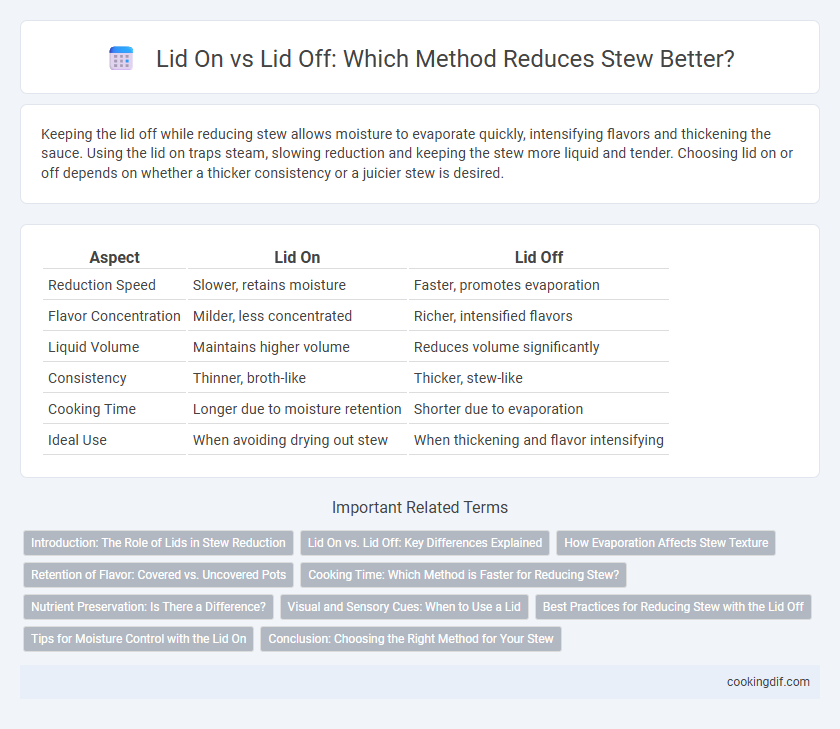Keeping the lid off while reducing stew allows moisture to evaporate quickly, intensifying flavors and thickening the sauce. Using the lid on traps steam, slowing reduction and keeping the stew more liquid and tender. Choosing lid on or off depends on whether a thicker consistency or a juicier stew is desired.
Table of Comparison
| Aspect | Lid On | Lid Off |
|---|---|---|
| Reduction Speed | Slower, retains moisture | Faster, promotes evaporation |
| Flavor Concentration | Milder, less concentrated | Richer, intensified flavors |
| Liquid Volume | Maintains higher volume | Reduces volume significantly |
| Consistency | Thinner, broth-like | Thicker, stew-like |
| Cooking Time | Longer due to moisture retention | Shorter due to evaporation |
| Ideal Use | When avoiding drying out stew | When thickening and flavor intensifying |
Introduction: The Role of Lids in Stew Reduction
Using a lid on a stew pot traps steam and moisture, slowing the reduction process by minimizing evaporation. In contrast, cooking with the lid off allows steam to escape, accelerating liquid concentration and intensifying flavors. Choosing whether to cover a stew impacts cooking time and the final texture of ingredients.
Lid On vs. Lid Off: Key Differences Explained
Lid on during stew reduction traps steam, maintaining moisture and cooking stew evenly while concentrating flavors gently over time. Lid off allows steam to escape rapidly, intensifying flavor concentration by evaporating liquid faster and thickening the stew. Choosing lid on preserves tenderness and prevents drying, whereas lid off accelerates reduction for thicker, richer consistency.
How Evaporation Affects Stew Texture
Keeping the lid off a stew allows steam to escape, promoting evaporation that thickens the broth and concentrates flavors for a richer, heartier texture. Leaving the lid on traps moisture, resulting in a thinner, more diluted stew with softer ingredients. Controlling evaporation by adjusting the lid position directly influences stew consistency and intensity of taste.
Retention of Flavor: Covered vs. Uncovered Pots
Using a lid on a stew pot traps steam and essential aromatic compounds, enhancing flavor retention by preventing volatile compounds from escaping. Cooking stew uncovered allows evaporation, which concentrates flavors but can also cause loss of subtle aromas and moisture. For richer, more intense flavor with preserved aroma, simmering with the lid on balances reduction and flavor retention effectively.
Cooking Time: Which Method is Faster for Reducing Stew?
Reducing stew with the lid off speeds up evaporation, leading to a faster concentration of flavors and thicker consistency in less time. Cooking with the lid on traps steam, resulting in slower reduction but retaining more moisture and tenderness. Generally, lid off method reduces cooking time by accelerating liquid loss, making it the preferred choice for quicker stew thickening.
Nutrient Preservation: Is There a Difference?
Cooking stew with the lid on helps retain water-soluble vitamins such as vitamin C and B-complex by minimizing steam loss, preserving essential nutrients more effectively than cooking with the lid off. Lid-off reduction promotes faster evaporation and concentration of flavors but leads to greater nutrient degradation due to exposure to oxygen and heat. Studies show that maintaining a covered environment balances nutrient preservation while still allowing controlled reduction.
Visual and Sensory Cues: When to Use a Lid
Keeping the lid off while reducing stew allows steam to escape, intensifying flavors and thickening the liquid, which is visually evident by the bubbling surface and a richer aroma. Conversely, using a lid traps moisture, resulting in a more liquid consistency and subtler scent, ideal when a gentler reduction is desired. Visual cues like a rapidly simmering surface signal the effectiveness of lid-off cooking, while a steady, less vigorous simmer suggests the lid should remain on to preserve moisture and flavor balance.
Best Practices for Reducing Stew with the Lid Off
Reducing stew with the lid off allows steam to escape, concentrating flavors and thickening the broth more effectively. Maintaining a gentle simmer prevents burning while promoting even evaporation for optimal consistency. Stirring occasionally ensures that ingredients cook uniformly and prevents sticking or scorching during the reduction process.
Tips for Moisture Control with the Lid On
Keeping the lid on while reducing stew helps retain moisture and intensifies flavors by trapping steam and preventing evaporation. To control moisture effectively with the lid on, simmer the stew gently and slightly offset the lid to allow minimal steam escape, balancing reduction without drying out the ingredients. This method ensures tender meat and a rich, concentrated broth while maintaining the desired texture and moisture levels.
Conclusion: Choosing the Right Method for Your Stew
Choosing whether to keep the lid on or off when reducing stew depends on the desired consistency and flavor intensity; leaving the lid off accelerates evaporation, resulting in a thicker, more concentrated stew. Keeping the lid on retains moisture, producing a milder flavor and stew with more liquid. For a rich, hearty stew with deep flavors, opt for lid off reduction, while lid on suits a soupier texture with balanced taste.
Lid On vs Lid Off for reducing stew Infographic

 cookingdif.com
cookingdif.com